Wistron NeWeb BQ12B TravelMate 430 Series Notebook w/ 802.11b LAN User Manual manual EM9 NB
Wistron NeWeb Corporation TravelMate 430 Series Notebook w/ 802.11b LAN manual EM9 NB
Quick User Guide
IEEE 802.11b Mini PCI Module
EM9-NB
Users Guide
1
Federal Communication Commission Interference Statement
This equipment has been tested and found to comply with the limits for a Class B
digital device, pursuant to Part 15 of the FCC Rules. These limits are designed to
provide reasonable protection against harmful interference in a residential installation.
This equipment generates, uses and can radiate radio frequency energy and, if not
installed and used in accordance with the instructions, may cause harmful interference
to radio communications. However, there is no guarantee that interference will not
occur in a particular installation. If this equipment does cause harmful interference to
radio or television reception, which can be determined by turning the equipment off
and on, the user is encouraged to try to correct the interference by one of the
following measures:
- Reorient or relocate the receiving antenna.
- Increase the separation between the equipment and receiver.
- Connect the equipment into an outlet on a circuit different from that to
which the receiver is connected.
- Consult the dealer or an experienced radio/TV technician for help.
FCC Caution: To assure continued compliance, (example - use only shielded
interface cables when connecting to computer or peripheral devices) any
changes or modifications not expressly approved by the party responsible for
compliance could void the user's authority to operate this equipment.
This device complies with Part 15 of the FCC Rules. Operation is subject to the
following two conditions:
(1) This device may not cause harmful interference, and
(2) This device must accept any interference received, including interference
that may cause undesired operation.
IMPORTANT NOTE:
FCC Radiation Exposure Statement:
This equipment complies with FCC radiation exposure limits set forth for an
uncontrolled environment. This transmitter must not be co-located or operating
in conjunction with any other antenna or transmitter.
2
Table of Contents
Regulatory Information......................................................錯誤! 尚未定義書籤。
Table of Contents...........................................................................................................2
1. Quick Software Installation Guide...............................................................................3
2. Step-by-Step Software Installation Guide ...................................................................6
2.1 INSTALLATION UNDER WINDOWS XP...............................................................................................................6
2.2 INSTALLATION UNDER WINDOWS 98SE/2000/ME...........................................................................................7
3. Software Uninstallation Guide ....................................................................................9
3.1 UNINSTALLATION UNDER WINDOWS XP..........................................................................................................9
3.2 UNINSTALLATION UNDER WINDOWS 98SE/2000/ME....................................................................................11
4. Configuration ............................................................................................................ 12
4.1 CONFIGURATION UNDER WINDOWS XP.........................................................................................................12
4.2 CONFIGURATION UNDER WINDOWS 98SE/2000/ME......................................................................................16
5. Using IEEE802.11b WLAN Utility............................................................................... 20
5.1 LAN STATUS.................................................................................................................................................20
5.2 LINK INFORMATION........................................................................................................................................21
5.3 SITE SURVEY..................................................................................................................................................21
5.4 DIAGNOSTIC...................................................................................................................................................22
5.5 ABOUT...........................................................................................................................................................22
6. Networking Applications........................................................................................... 23
6.1 SURVEYING THE NETWORK NEIGHBORHOOD..................................................................................................23
6.2 FILE SHARING ................................................................................................................................................24
6.3 USING THE SHARED FOLDER...........................................................................................................................25
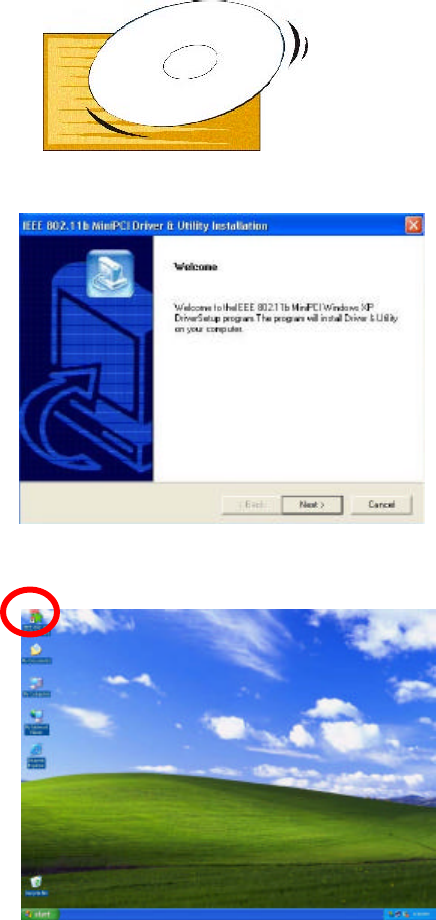
3
1. Quick Software Installation Guide
If you are familiar with computer networking, this Quick Start Guide is the
fastest way for you to establish your wireless network.
If you need more information than this Quick Start Guide can provide, the
following chapters will guide you through the necessary steps. The quick
installation guide is based on Windows XP.
1.
Insert the installation software
CD into the computer.
2.
Follow the displayed instructions
to complete installation.
3.
WLAN icon displays on the
desktop after the installation.
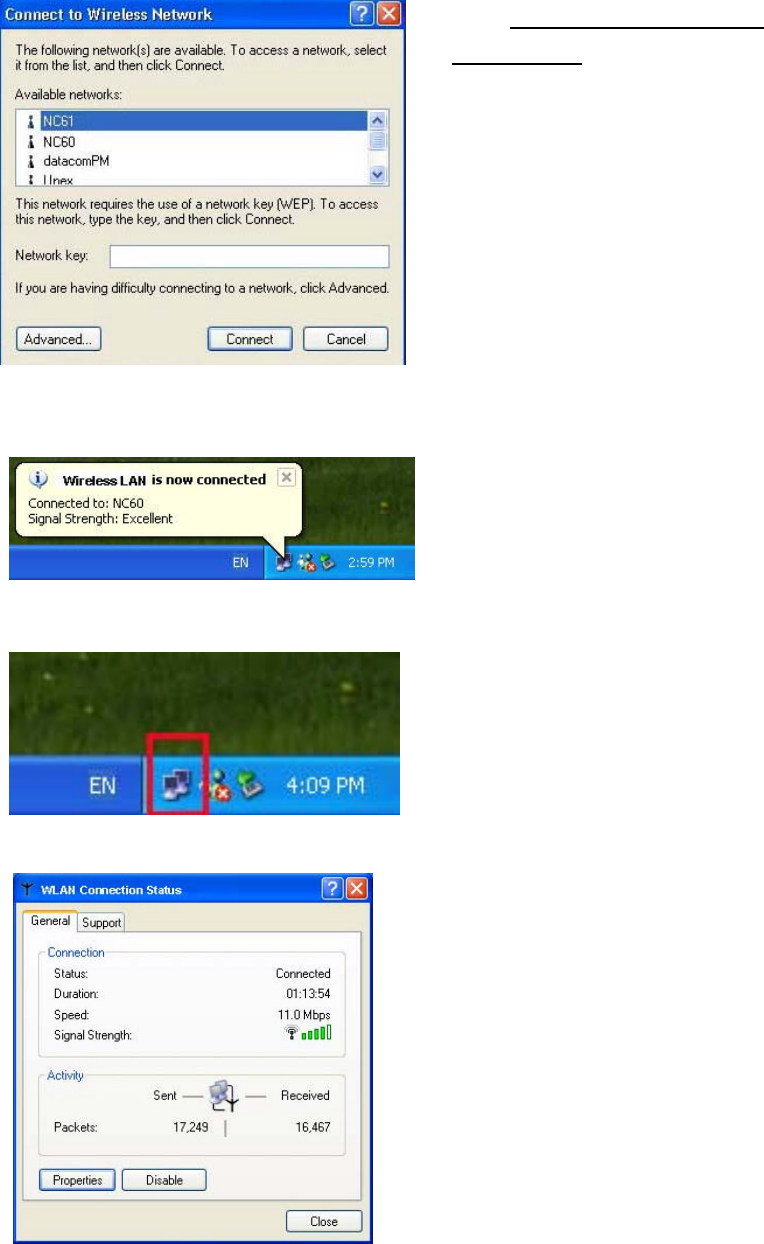
4
4.
Click Start>Settings>Network
Connections, and double click
the Wireless Network
Connection of “802.11b
Wireless LAN PCI Card”.
From the available networks list,
choose one network and enter
the network key (if necessary).
Click “Connect”.
5.
From Windows System Tray, a
dialog box pops up which shows
you the Network name and the
Signal Strength.
6.
Double click on “Wireless
Network Connection” icon from
the Windows System Tray.
7.
Click “Properties”.
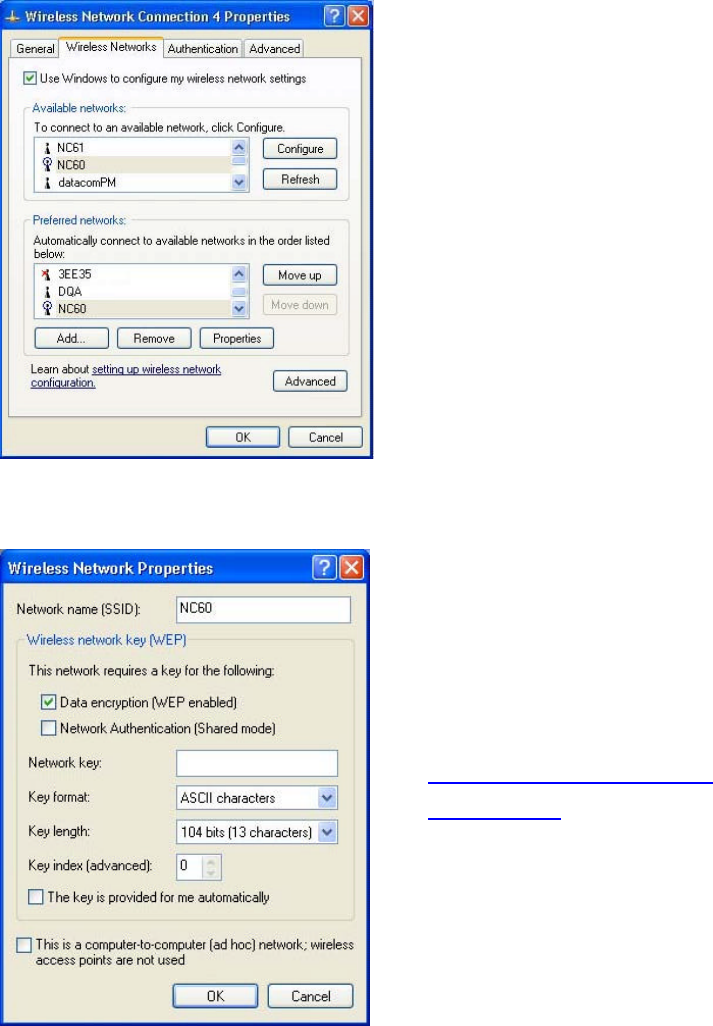
5
8.
Select “Wireless Networks” tab.
9.
Click “Configure” button to view
and edit the WEP settings.
You may click “Learn about
setting up wireless network
configuration” on Wireless
Networks tab to learn more
about wireless network
configuration.
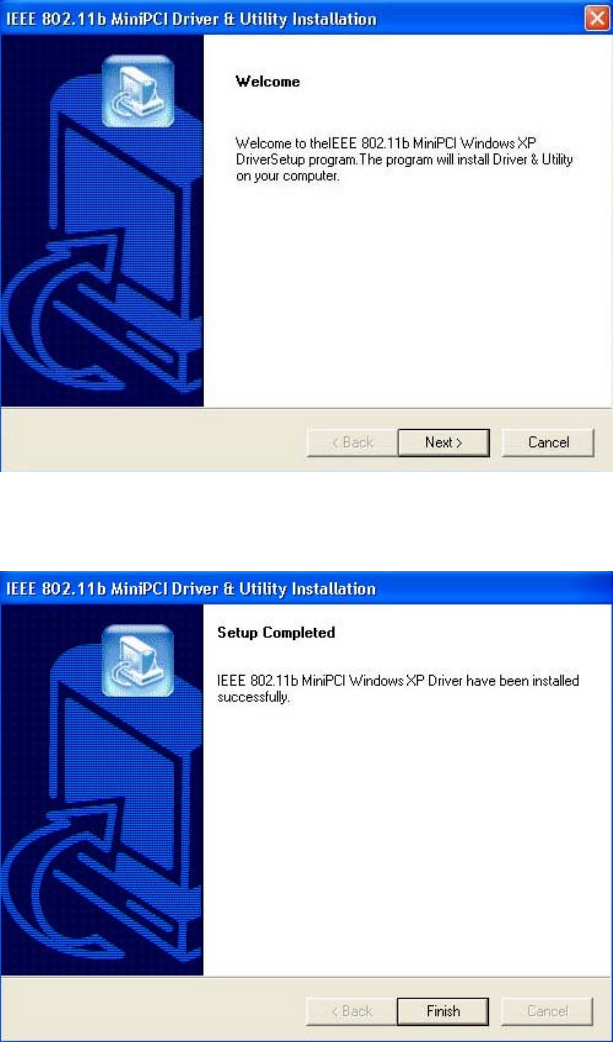
6
2. Step-by-Step Software Installation Guide
2.1 Installation Under Windows XP
1. Insert the IEEE802.11b WLAN installation CD into your CD-ROM drive.
The setup program will then automatically start.
2. Click ”Next”.
3. Click “Finish”.
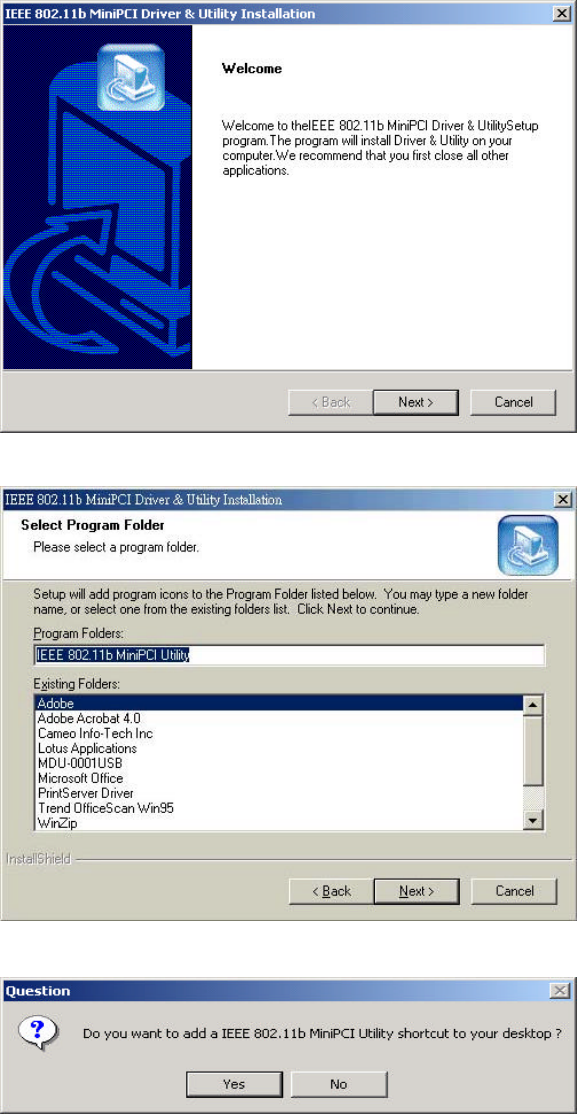
7
2.2 Installation Under Windows 98SE/2000/ME
1. Insert the IEEE802.11b WLAN installation CD into your CD-ROM drive.
The setup program will then automatically start.
2. Click ”Next”.
3. Click ”Next”.
4. Click “Yes” to create a shortcut.
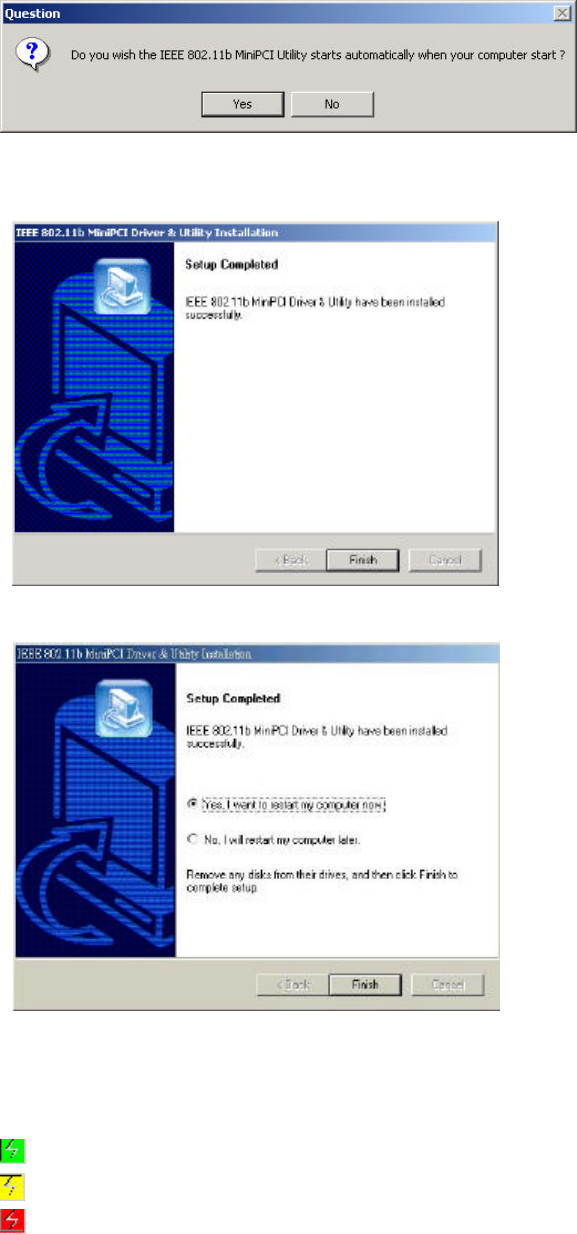
8
5. Click “Yes” to auto start the IEEE802.11b MiniPCI Utility every time the
computer starts.
6. The installation is complete. Click “Finish”.
Restart your computer if necessary.
7. From the Windows System Tray, you can find a connection status icon.
Three different colors indicate different connection status.
Connected (Green)
Low quality (Yellow)
Disconnected (Red)
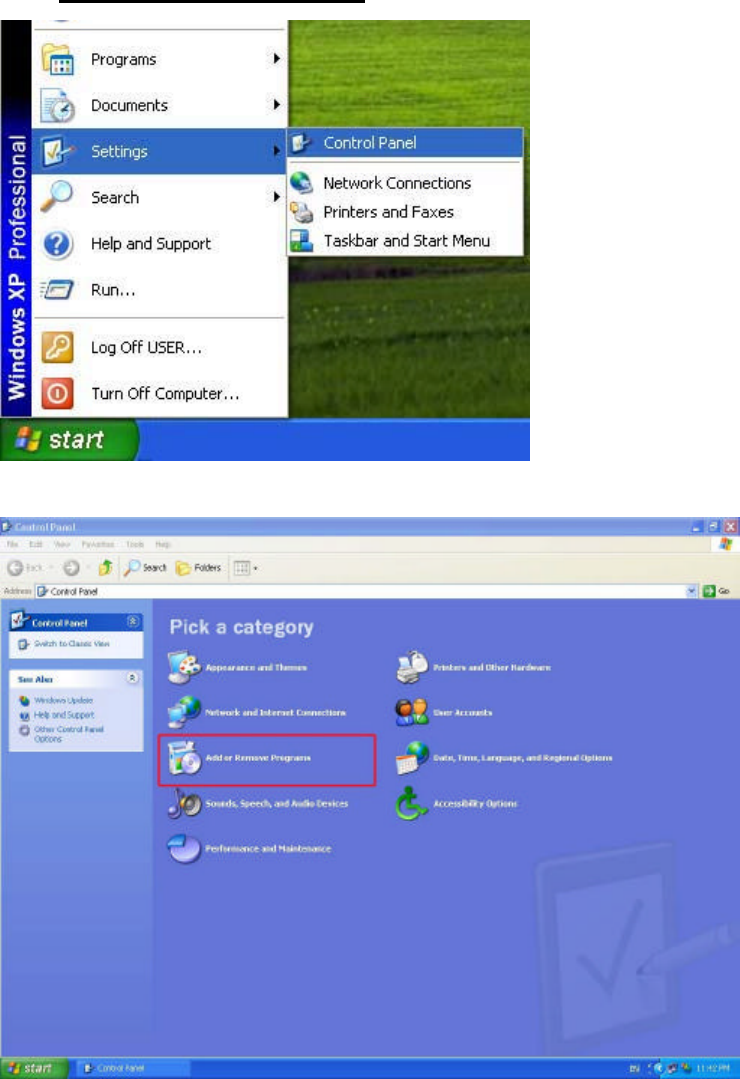
9
3. Software Uninstallation Guide
3.1 Uninstallation Under Windows XP
1. Close the IEEE802.11b MiniPCI Utility.
2. Click Start >Settings>Control Panel.
3. Select “Add or Remove Programs”.
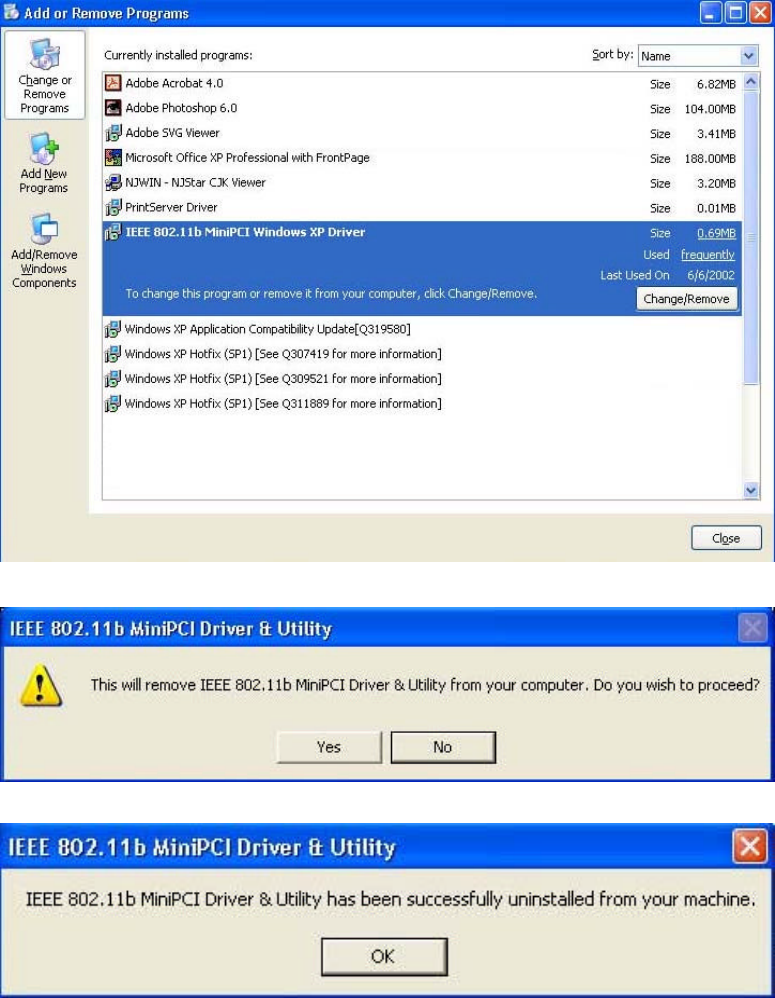
10
4. Select “IEEE802.11b miniPCI Windows XP Driver”. Click
“Change/Remove”.
5. Click “Yes”.
6. Click “OK”.
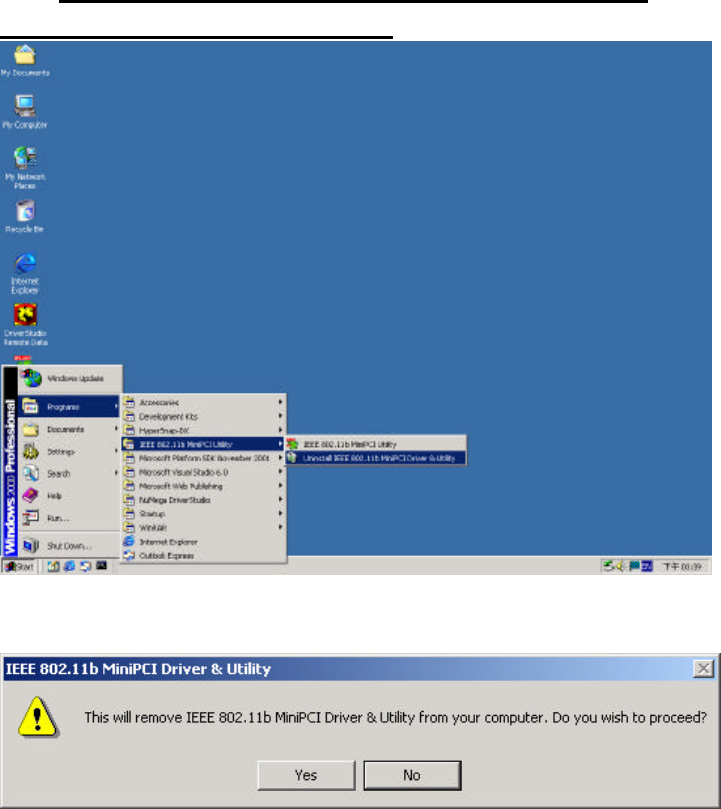
11
3.2 Uninstallation Under Windows 98SE/2000/ME
1. Close the IEEE802.11b MiniPCI Utility.
2. Click Start > Programs > IEEE802.11bMiniPCI Utility>Uninstall
IEEE802.11b MiniPCI Driver & Utility.
3. Click “Yes”.

12
4. Configuration
4.1 Configuration Under Windows XP
1. Click “Start>Settings>Network Connections, and double click the Wireless
Network Connection of “802.11b Wireless LAN PCI Card”.
2. From the available networks list, choose one network and enter the network key
(if necessary). Click “Connect”.
3. From Windows System Tray, a dialog box pops up which shows you the Network
name and the Signal Strength.
4. Double click on “Wireless Network Connection” icon from the Windows
System Tray.
5. Click “Properties”.
6. View and edit the settings from each tab: General, Wireless Networks,
Authentication and Advanced.
7. On Wireless Networks tab, click “Configure” button to view and edit the WEP
settings.
8. You may click “Learn about setting up wireless network configuration” on
Wireless Networks tab to learn more about wireless network configuration.
Contents are as follows:
To set up automatic wireless network configuration
1. Open Network Connections.
2. Right-click Wireless Network Connection, and then click Properties.
3. On the Wireless Networks tab, do one of the following:
o To enable automatic wireless network configuration, select the Use Windows
to configure my wireless network settings check box. This check box is
selected by default. For information about what happens when you enable
automatic wireless network configuration, see Notes.
o To disable automatic wireless network configuration, clear the Use Windows
to configure my wireless network settings check box.
4. To connect to an existing wireless network, do one of the following:
Access point (infrastructure)
o To connect to an existing access point (infrastructure) network, under
Available networks, click the network name, and then click Configure.

13
In Wireless Network Properties, specify the wireless network key (Wired
Equivalent Privacy) settings, or, if the network key is automatically provided
for you (for example, the key is stored on the wireless network adapter given
to you by your administrator), select the The key is provided for me
automatically check box. If you are unsure about whether a network key is
needed or which settings you need to enter, contact your network
administrator or the wireless network adapter manufacturer.
Important
o If a network does not broadcast its network name, it will not appear under
Available networks. To connect to an access point (infrastructure) network
that you know is available but that does not appear under Available
networks, under Preferred networks, click Add. In Wireless Network
Properties, specify the network name (Service Set Identifier) and, if needed,
the wireless network key settings.
Computer-to-computer (ad hoc)
o To connect to an existing computer-to-computer (ad hoc) network, under
Available networks, click the network name, and then click Configure.
In Wireless Network Properties, specify the wireless network key
(Wired Equivalent Privacy) settings, or, if the network key is
automatically provided for you (for example, the key is stored on the
wireless network adapter given to you by your administrator), select
the The key is provided for me automatically check box. If you are
unsure about whether a network key is needed or which settings you
need to enter, contact your network administrator or the wireless
network adapter manufacturer.
If you want to connect to a computer-to-computer (ad hoc) network
and both computer-to-computer and access point (infrastructure)
networks are within range of your computer, click Advanced, and then
click Computer-to-computer (ad hoc) networks only.
5. To configure a new wireless network connection, click Add, and then do the
following:
o In Wireless Network Properties, specify the network name (Service Set
Identifier) and, if needed, the wireless network key settings.
o If the network connection that you are configuring is to a
computer-to-computer (ad hoc) network, select the This is a
computer-to-computer (ad hoc) network; wireless access points are not
used check box.
6. To change the order in which connection attempts to preferred networks are made,
under Preferred networks, click the wireless network that you want to move to a
new position on the list, and then click Move up or Move down.
14
7. To change the wireless network connection settings for a network that is listed in
Preferred networks, click the wireless network for which you want to change
settings, click Properties, and then change the settings as needed.
8. To remove a wireless network from the list of preferred networks, under Preferred
networks, click the wireless network that you want to remove, and then click
Remove.
9. To update the list of available networks that are within range of your computer, click
Refresh.
10. To automatically connect to available networks that do not appear in the Preferred
networks list, click Advanced, and then select the Automatically connect to
non-preferred networks check box.
Notes
• To open Network Connections, click Start, point to Settings, click Control Panel,
and then double-click Network Connections.
• When you enable automatic wireless network configuration, you can connect to an
existing wireless network, change wireless network connection settings, configure a
new wireless network connection, and specify preferred wireless networks. You will
be notified when new wireless networks are available. After you select a wireless
network, your wireless network adapter will be automatically configured to match the
settings of that network, and a network connection attempt will be made. For more
information, see Related Topics.
• To configure settings on the Wireless Networks tab, you must be logged on as an
administrator, and you must use a wireless network adapter that supports the Wireless
Zero Configuration service. If you are unsure whether your wireless network adapter
supports the Wireless Zero Configuration service, contact your network administrator
or the wireless network adapter manufacturer. For more information about automatic
wireless network configuration, see Related Topics.
• If you are using third-party wireless networking software, clear the Use Windows to
configure my wireless network settings check box.
• If you are unable to connect to an existing wireless network and the name of the
network that you want to connect to appears under the Preferred networks list, click
the preferred network name, and then click Properties. In Wireless Network
Properties, review the settings to ensure that they are correct. If you are unsure
whether the settings are correct, contact your network administrator or the wireless
network adapter manufacturer.
• If the Preferred networks list includes both access point (infrastructure) and
computer-to-computer (ad hoc) networks, you cannot move a computer-to-computer

15
network to a position in the list that is higher than the position of an access point
network.
• To provide enhanced security for 802.11 wireless networks and for wired Ethernet
networks, IEEE 802.1x authentication is enabled by default. For more information
about how to set up 802.1x authentication, see Related Topics.
Related Topics

16
4.2 Configuration Under Windows 98SE/2000/ME
1. Click the connection status in Windows System Tray. Select “Site Survey” tab.
2. From the available network list, you can check the Signal Strength and then
decide which network to join.
3. Select “Setting” tab. Enter the SSID and then choose the Network Type.
Choose a channel if 802.11 AdHoc mode is selected.
4. Click “Advance” button to set Transmission Rate, Power Saving and WEP. Click
“Apply”.
5. Click “Apply” to implement the modified settings.
Details of each setting are as follows:
u SSID is the group name that will be shared by every member of your wireless
network .You will only be able to connect with an Access Point (AP), which has
the same SSID. Note that the SSID will be case sensitivity.
u Channel: If the Infrastructure Mode is selected, this parameter will not be active.
Channel shows radio channel numbers used for networking. Channel number
must be the same between stations so computers can communicate in the same
local LAN.
Country Channel Range
USA/Canada 11 (1~11)
Most of Europe/Australia 13 (1~13)
France 4 (10~13)
Japan 13 (1~13) or 14th
u Transmission Rate
Four options are available:
A. Fully Auto (Default)
B. Fixed 11Mbps
C. Fixed 5.5Mbps
D. Auto 1 or 2 Mbps
If you enable the “Power Saving” mode, the PCI module can work with low
power consumption but the throughput may be slow down.
17
u Encryption Function
You may enhance the security of your network by enabling the “Encryption”
function. The WEP Required Mode enables you to define the encryption keys.
! Caution:
Using “Encryption” function requires all computers of the network to enable the
“Encryption” function. The WEP key needs to be the same for all IEEE802.11b
stations.
Follow the steps below to set your WEP Required Mode:
(1) Select one mode by clicking the pull-down button in the WEP Required
Mode frame. Set the WEP key in your PCI module by selecting one of the
following modes:
A. ASCII 64 bits
B. ASCII 128 bits
C. Hex 64 bits
D. Hex 128 bits
E. Auto 64 bits
F. Auto 128 bits
(2) If you select “Auto 64 bits” or “Auto 128 bits” mode, type any letter or
phrase in the “Pass Phrase” field (i.e. Pass or Test…) and the WEP key
will be automatically generated in the Key field.
If you enter out-of range characters for the WEP key, the Utility will prompt a
warning message to ask for the correct characters. Without enough
hexadecimal value or ASCII character in the “Key” field, the “Apply” button
will not be enabled.
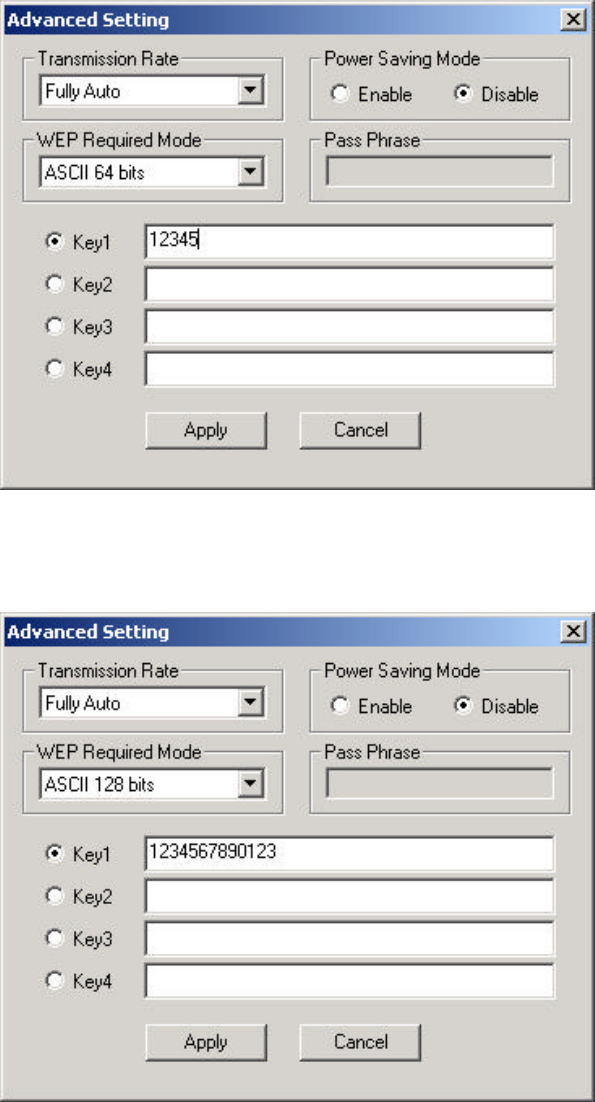
18
A. ASCII 64 bits: This mode requires 5 ASCII characters range from 0~9 and
a(A)~z(Z).
B. ASCII 128 bits: This mode needs 13 ASCII characters range from 0~9 and
a(A)~z(Z).
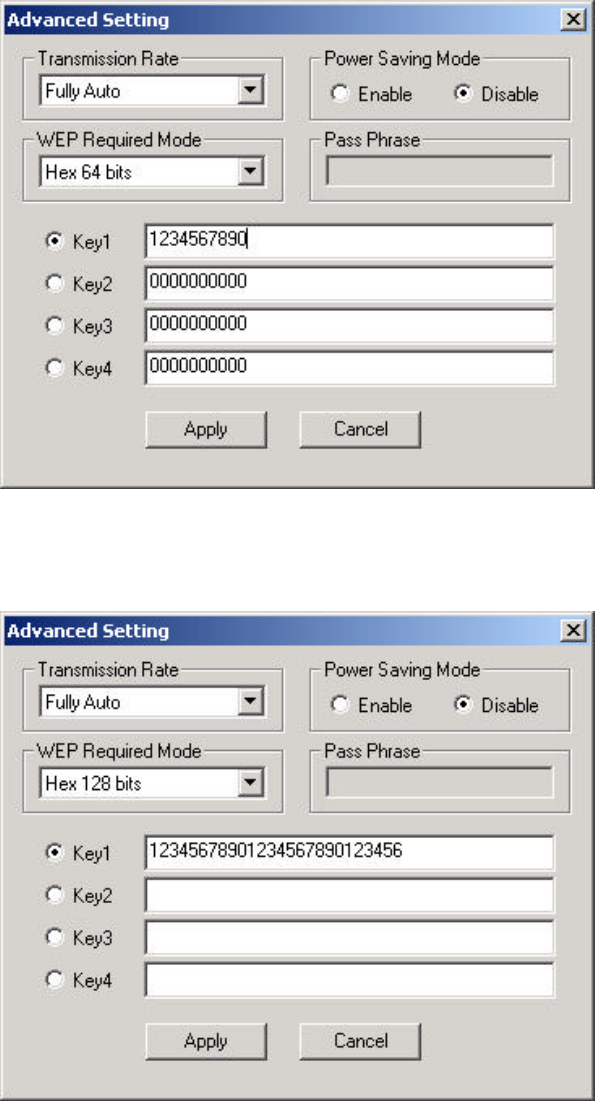
19
C. Hex 64 bits: This mode needs 10 hexadecimal numbers for use and will have
the limit of 10 Hexadecimal value of 0~9 and a(A)~f(F).
D. Hex 128 bits: This mode needs 26 hexadecimal value for use and will have
the limit of 26 Hexadecimal number from range of 0~9 and a(A)~f(F).
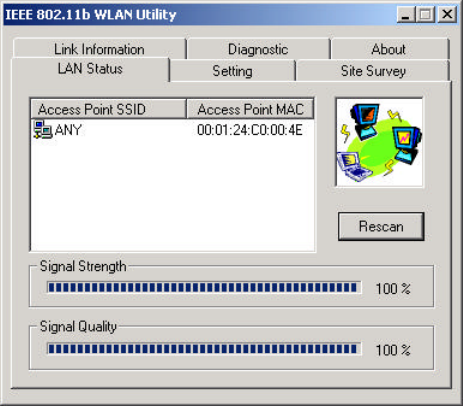
20
5. Using IEEE802.11b WLAN Utility
5.1 LAN Status
If you want to know the connecting status in Infrastructure Mode or 802.11Ad
Hoc Mode, choose LAN Status tab in IEEE802.11b WLAN Utility window.
1. Infrastructure Mode:
l The columns of SSID and MAC of the Access Point, which your
computer connects to, will appear in the screen if you choose the
Infrastructure Mode.
l Double click the Access Point SSID (under the Infrastructure
Mode) to access to the Microsoft Network Neighborhood folder to
find other on-line computers.
l You can see the status of the Link Quality and Signal Strength
under the LAN Status page.
2. 802.11 Ad Hoc Mode:
l The columns of Station Name and MAC Address of your station
will appear if you choose the 802.11Ad Hoc Mode.
l Double click the name to display the content of your computer or
double click Network Neighbors to access to the Microsoft
Network Neighborhood folder to find other on-line computers.
l Click “ Rescan “ to find other computers.
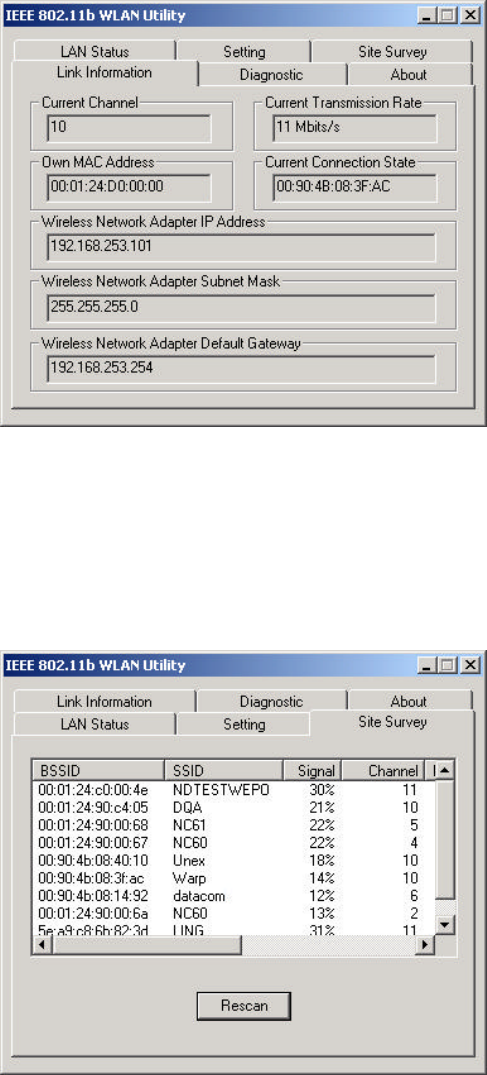
21
5.2 Link Information
The link information provides information of Current Channel, Current Transmission
Rate, Own MAC Address, Current Connection State, Wireless Network Adapter IP
Address, Wireless Network Adapter Subnet Mask, and Wireless Network Adapter
Default Gateway.
5.3 Site Survey
In this dialog box, you may get all the information of each Access Point within the
communication range of your MiniPCI module. You may choose a preferred one to
connect to according to the information (Connecting to the Access Point with the
strongest signal is recommended.).
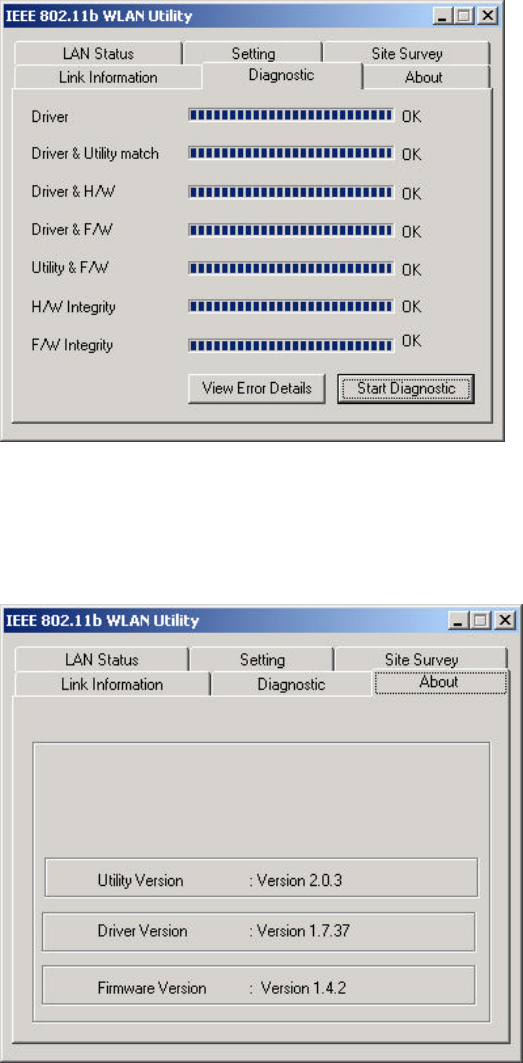
22
5.4 Diagnostic
To check if there are any errors in the hardware, firmware, and software of your PCI
module, you may enter this dialog box and click the “Start Diagnostic” button. If there
are any errors, please click the “View Error Details” and print it out to present to your
dealer/ distributor.
5.5 About
From this dialog box, you can get the details such as the version information of each
Software component.
23
6. Networking Applications
Available network applications are as follows:
l To Survey the network neighborhood
l To Share Your Folder with Your Network Member(s)
l To Share Your Printer with Your Network Member(s)
l To Access the Shared Folder(s)/File(s) of Your Network
Members(s)
l To Use the Shared Printer(s) of Your Network Member(s)
In fact, the network applications of IEEE802.11b MiniPCI are the same as they
are in a wired network environment. You may refer to the following 3
examples of Surveying the Network Neighborhood, File Sharing and Using the
Shared Folder.
6.1 Surveying the Network Neighborhood
When multiple base stations are used in your wireless network, follow the steps below
to display other computers:
1. Double-click My Network Places to display all stations in your Microsoft
Windows Network Group.
2. To display other workgroups in the network environment, double-click Entire
Network.
3. If there is a second network operating system running in your network
environment (for example a Novell NetWare network), the “Entire Network”
window will also display available servers running under the second network
operating system. If you click on these servers, you may be asked to enter
your user name and password that applies to the other network operating
system. If you cannot find it, verify whether the other wireless computers are:
l Powered up and logged on to the network.
l Configured to operate with identical Microsoft Network settings
concerning:
n Networking Protocol.
n Wireless Network Name.
To enable the sharing of Internet access, you should set the WLAN mode as
“Infrastructure” and connect to the access point.
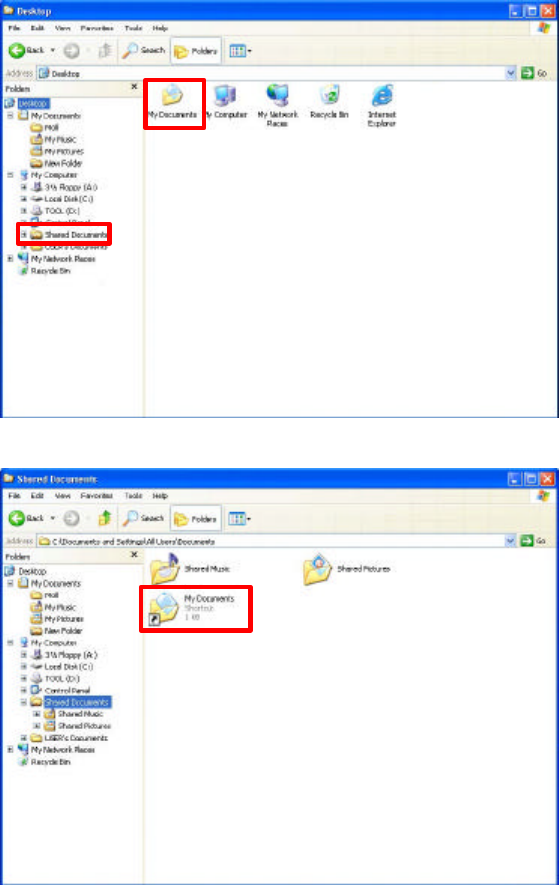
24
6.2 File Sharing
You may share files between computers that are logged onto the same
wireless network. For example, if you want to share your folder “My
Documents“ with other computers of the wireless network, please highlight
the folder “My Documents” and drag it to Shared Documents folder.
Sharing files in the IEEE802.11b wireless network will be like sharing files on a
wired LAN.
25
6.3 Using the Shared Folder
If you would like to access a shared folder stored in other stations of the same
network, please follow the process below:
1. Double-click the “My Network Places” icon, and then double-click the
computer where the shared folder is located.
2. Double-click the folder you want to connect to.
3. Now you may open the needed file(s).
Note: If a password is required, the Windows will prompt a password column
to you. Then you need to enter the password that had been assigned to this
shared folder.